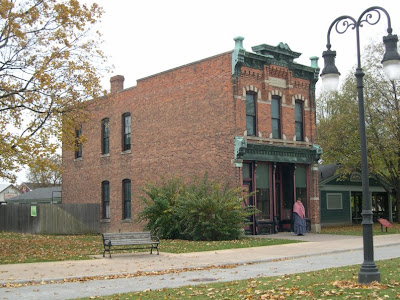1932 - Original Buildings No Longer in Greenfield Village
Kingston Cooper Shop (formerly known as Cooper Shop):
This 1785 structure from Kingston, New Hampshire, when rebuilt inside the Greenfield Village in 1932, became the oldest American craftshop in the Village.
The cooper built watertight hogshead (a large barrel or a large cask) for commerce, barrels for shipping fruits or vegetables, buckets for maple syrup, and wooden pails needed in every home. Fatened without glue or nails, the staves were bound together by hickory hoops, and the bottoms fitted into grooves in the sides.

The cooper used tools such as a froe, with which he split logs into boards and shingles; the joiner for smoothing edges; and the draw knife to shape the staves. While sitting on a shaving horse, he would use his feet to close the vise (by way of a lever) in which the staves are held.
The cooper was a valued craftsman, and that his work was well done is proved by the buckets nearly 200 years old still around in antique shops and museums to this day.
I would love to see a photograph of this building after its relocation because, according to the 1935/36 guidebook:
"The east side has been restored; the west is exactly as it was."
I can just imagine how awesome that must have looked!
 Unfortunately, like so many other wonderful buildings originally placed in the Village, it had been removed, first to a place inside the Henry Ford Museum (where I took the pictures you see here), and then it was taken apart and, from what I was told, placed into storage.
Unfortunately, like so many other wonderful buildings originally placed in the Village, it had been removed, first to a place inside the Henry Ford Museum (where I took the pictures you see here), and then it was taken apart and, from what I was told, placed into storage.
As you can see, the majority of the outside structure has been greatly modified.
A historic village without a cooper shop. How sad.
.
This 1785 structure from Kingston, New Hampshire, when rebuilt inside the Greenfield Village in 1932, became the oldest American craftshop in the Village.
The cooper built watertight hogshead (a large barrel or a large cask) for commerce, barrels for shipping fruits or vegetables, buckets for maple syrup, and wooden pails needed in every home. Fatened without glue or nails, the staves were bound together by hickory hoops, and the bottoms fitted into grooves in the sides.

The cooper used tools such as a froe, with which he split logs into boards and shingles; the joiner for smoothing edges; and the draw knife to shape the staves. While sitting on a shaving horse, he would use his feet to close the vise (by way of a lever) in which the staves are held.
The cooper was a valued craftsman, and that his work was well done is proved by the buckets nearly 200 years old still around in antique shops and museums to this day.
I would love to see a photograph of this building after its relocation because, according to the 1935/36 guidebook:
"The east side has been restored; the west is exactly as it was."
I can just imagine how awesome that must have looked!
 Unfortunately, like so many other wonderful buildings originally placed in the Village, it had been removed, first to a place inside the Henry Ford Museum (where I took the pictures you see here), and then it was taken apart and, from what I was told, placed into storage.
Unfortunately, like so many other wonderful buildings originally placed in the Village, it had been removed, first to a place inside the Henry Ford Museum (where I took the pictures you see here), and then it was taken apart and, from what I was told, placed into storage.As you can see, the majority of the outside structure has been greatly modified.
A historic village without a cooper shop. How sad.
.




Comments